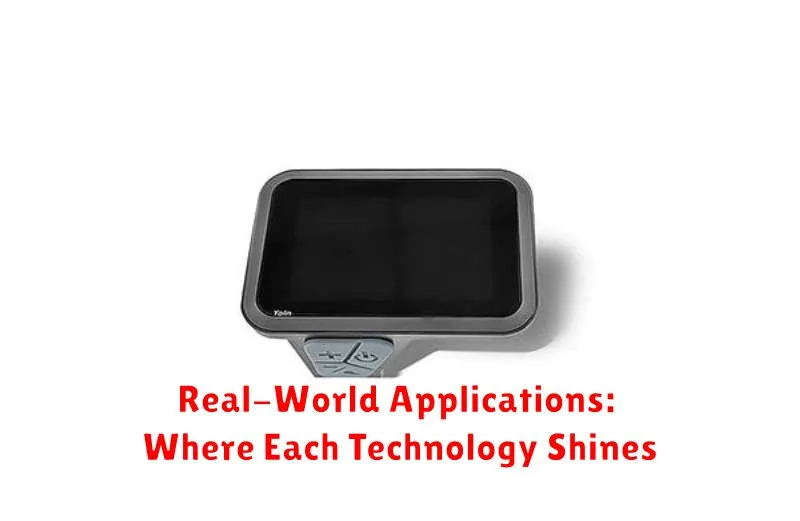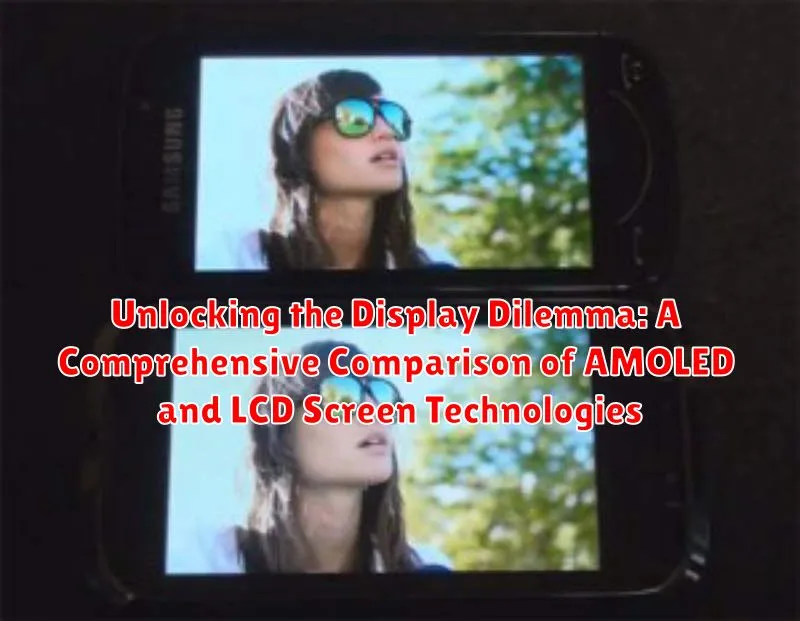In the ever-evolving landscape of display technology, consumers are constantly faced with the challenge of selecting the optimal screen for their devices. Two dominant technologies, AMOLED (Active Matrix Organic Light Emitting Diode) and LCD (Liquid Crystal Display), stand out as frontrunners. This comprehensive comparison aims to unlock the display dilemma by providing an in-depth analysis of AMOLED vs. LCD screens. We will explore their fundamental differences, strengths, and weaknesses, empowering readers to make informed decisions based on their individual needs and preferences when choosing smartphones, televisions, laptops, and other devices.
This article serves as a definitive guide, meticulously examining the key characteristics of both AMOLED and LCD technologies. We will delve into crucial aspects such as color accuracy, contrast ratio, brightness, power efficiency, viewing angles, and response time. Furthermore, we will address common misconceptions and provide objective data to clarify the advantages and disadvantages of each screen technology. By understanding the nuances of AMOLED and LCD displays, readers can confidently navigate the market and select the technology that best suits their viewing habits and application requirements, ultimately enhancing their user experience.
Understanding the Basics: What are LCD and AMOLED Displays?
In the realm of display technology, LCD (Liquid Crystal Display) and AMOLED (Active Matrix Organic Light Emitting Diode) are two dominant players. Understanding their fundamental differences is crucial for appreciating their respective strengths and weaknesses.
LCD Displays
LCDs rely on liquid crystals to modulate light. A backlight illuminates these crystals, which then selectively allow or block light to create the image. LCDs are known for their brightness and relatively lower manufacturing costs.
AMOLED Displays
AMOLEDs, on the other hand, are emissive displays. Each pixel is composed of organic compounds that emit light when an electric current is applied. This eliminates the need for a backlight, enabling deeper blacks and potentially lower power consumption in certain scenarios. AMOLED technology generally provides superior contrast ratios.
How LCD (Liquid Crystal Display) Technology Works
LCD technology utilizes liquid crystals to modulate light and create images. These crystals are situated between two polarized glass panels.
A backlight, typically a LED (Light Emitting Diode), provides the light source. This light passes through the first polarizing filter.
The liquid crystals, when subjected to an electric field, twist and align themselves. This alignment either allows light to pass through or blocks it, effectively controlling the brightness of each pixel.
A color filter array, composed of red, green, and blue subpixels, is used to generate a full spectrum of colors. The amount of light passing through each subpixel determines the final color displayed.
Finally, the light passes through a second polarizing filter, oriented perpendicularly to the first, further refining the light and creating the visible image.
How AMOLED (Active Matrix Organic Light Emitting Diode) Technology Works

AMOLED, or Active Matrix Organic Light Emitting Diode, represents a significant advancement in display technology. Unlike LCDs that require a backlight, AMOLED displays are emissive, meaning each pixel generates its own light. This is achieved through the use of organic compounds that emit light when an electric current is applied.
The “Active Matrix” part of the acronym refers to the TFT (Thin-Film Transistor) backplane. Each pixel is controlled by its own TFT, allowing for individual pixel control and faster response times compared to passive matrix OLED displays. This enables superior image quality and smoother motion.
Key Features of AMOLED Operation:
- Organic Compounds: Emissive materials that produce light when electricity is applied.
- Individual Pixel Control: Each pixel is independently controlled by a TFT.
- No Backlight Required: Self-emissive nature leads to thinner and more energy-efficient displays.
Key Differences: AMOLED vs. LCD – A Side-by-Side Comparison
The fundamental distinction between AMOLED and LCD technologies lies in their light emission mechanisms. LCDs require a backlight to illuminate the liquid crystals, while AMOLEDs feature self-emissive pixels, meaning each pixel generates its own light. This key difference dictates variations in several performance aspects.
Here’s a brief comparison:
- Contrast Ratio: AMOLEDs typically offer infinite contrast ratios due to their ability to completely turn off individual pixels, resulting in true blacks. LCDs have limited contrast ratios.
- Response Time: AMOLEDs generally have faster response times, leading to smoother motion and reduced ghosting.
- Viewing Angles: AMOLEDs maintain consistent color and brightness across wider viewing angles compared to LCDs, particularly traditional TFT-LCDs.
- Manufacturing Cost: AMOLED production can be more expensive, contributing to higher device prices.
These differences make each technology suitable for varying applications and consumer preferences.
Contrast Ratio and Black Levels: The AMOLED Advantage
One of the most significant advantages of AMOLED displays lies in their superior contrast ratio and ability to produce true black levels. This stems from the fundamental difference in how each technology generates light.
LCDs rely on a backlight that illuminates the liquid crystal layer. Even when attempting to display black, some light inevitably leaks through, resulting in a dark gray rather than a true black.
AMOLEDs, on the other hand, feature self-emissive pixels. To display black, the pixel simply turns off completely, emitting no light whatsoever. This results in an infinite contrast ratio, as the difference between the brightest white and the darkest black is maximized. This leads to richer, more vibrant images with greater depth and detail. The enhanced contrast is particularly noticeable in dark scenes, where the details are far more discernible on an AMOLED display.
Color Accuracy and Gamut: Which Display Reigns Supreme?
When evaluating display technologies, color accuracy and gamut are critical factors. Color accuracy refers to how faithfully a display can reproduce colors as they are intended to be seen. Gamut, on the other hand, defines the range of colors a display can produce.
Typically, LCDs have been known for their relatively accurate color reproduction, particularly in professional applications where accurate color representation is paramount. LCDs, especially those with IPS (In-Plane Switching) technology, often excel in rendering colors close to the sRGB standard, making them suitable for tasks like photo editing and graphic design.
AMOLED displays have made significant strides in color accuracy. While early AMOLED screens were often criticized for oversaturated colors, modern AMOLED technology offers various color profiles, including modes that adhere closely to industry standards like sRGB and DCI-P3. This allows users to switch between vibrant, saturated colors and more accurate, natural-looking colors depending on their preference and the application.
In conclusion, both display technologies are capable of achieving excellent results in color accuracy and gamut coverage. The “reign” depends on specific implementation, calibration, and user preference, with both technologies now offering viable solutions for color-critical work.
Power Consumption: AMOLED vs. LCD Efficiency
Power consumption is a critical factor when choosing between AMOLED and LCD displays. Generally, AMOLED displays are more energy-efficient when displaying darker colors or black, as individual pixels can be turned off completely. This leads to significant power savings in dark mode scenarios.
LCD displays, on the other hand, typically consume more power when displaying darker images because the backlight remains on even for black pixels. However, LCDs can be more efficient when displaying brighter, fully white images because they utilize a consistent backlight source.
The actual power consumption varies based on screen brightness, content displayed, and specific display technology implementation. Modern AMOLED panels have made strides in efficiency, closing the gap with LCDs in certain use cases.
Lifespan and Burn-in: Addressing AMOLED Concerns
One of the primary concerns surrounding AMOLED displays is their lifespan and susceptibility to burn-in, a phenomenon where prolonged display of static images leaves a permanent ghost image on the screen. This occurs because the organic compounds in AMOLED pixels degrade over time, and uneven usage can lead to differential aging.
While early AMOLED displays were indeed more prone to burn-in, significant advancements have been made to mitigate this issue. Manufacturers now employ various techniques, including pixel shifting, subpixel rendering, and automatic brightness adjustments, to distribute pixel wear more evenly. Furthermore, the organic materials themselves have been improved for enhanced longevity.
LCD displays, on the other hand, do not suffer from burn-in due to their different underlying technology. However, they can experience backlight degradation over extended use, leading to reduced brightness and color accuracy. Modern AMOLED displays often have comparable or even superior lifespans to LCDs under typical usage conditions, alleviating many of the initial concerns about long-term reliability.
Cost Considerations: The Price Factor in Display Choice
The price of displays is a significant factor for both manufacturers and consumers. Generally, LCD panels have been more cost-effective to produce at scale compared to AMOLED displays. This difference in manufacturing complexity and material costs historically translated into lower prices for devices utilizing LCD technology.
However, the price gap between LCD and AMOLED is narrowing. Increased AMOLED production and technological advancements have led to a decrease in AMOLED manufacturing costs. Despite this trend, LCDs, particularly in larger sizes, often remain the more affordable option. The specific resolution, size, and features of a display also influence its final price.
Ultimately, the cost-effectiveness of choosing between AMOLED and LCD depends on the device, intended use, and budget. While high-end devices often incorporate AMOLED for superior image quality, LCDs remain a competitive option for budget-conscious consumers seeking reliable performance.
Real-World Applications: Where Each Technology Shines

Both AMOLED and LCD technologies have found their niche in various applications due to their distinct strengths. LCDs, with their mature technology and cost-effectiveness, are widely utilized in desktop monitors, TVs, and entry-level smartphones. Their brightness and clarity make them suitable for environments with high ambient light.
AMOLED displays, renowned for their vibrant colors, high contrast, and thin profiles, dominate the premium smartphone market, high-end TVs, and wearables like smartwatches. The individual pixel illumination allows for “true black” and contributes to superior viewing experiences, especially in dark environments. Furthermore, the flexibility of AMOLED has enabled the creation of foldable devices and curved displays, opening up new possibilities in industrial design.

